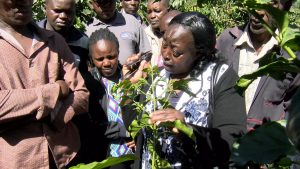Coffee Agronomist John Chege has urged coffee farmers to leverage on the dry months of January and February to carry out some vital practices to ensure increased cherry production throughout the year.
Speaking during a farmers’ education day at Marumi Cooperative Coffee Society in Kigumo, Chege noted that some practices like cycle renewing, correct pruning, soil testing and foliar application would certainly increase the production.

He urged farmers to shun incorrect practices that not only destroyed the bushes but also affected productivity, leading to low prices at the coffee auction and less earnings for the farmer.
“After harvesting in October, November and December, farmers are supposed to carry out pruning to increase production so as to reduce the habitat of pests and diseases,” he said.
He said timely pruning of the coffee bushes also allowed sunlight penetration that acts as a catalyst for flowering because bushes that are in the shade do not flower well, leading to low production.
The agronomist advises farmers to change the coffee cycle every five years, noting that January and February were the ideal times to do a cycle change by getting rid of all the old bushes.
He urges farmers to ensure they change the cycle every five years by getting rid of all old coffee bushes to get the young, vibrant bushes that are more productive and are highly resistant to pests and diseases.
According to Chege, during the dry months, it is the ideal time for a farmer to carry out soil sampling.
“Testing the soil is a must-do for any farmer who intends to reap returns from coffee farming because the soil pH majorly determines the nutrients that will be available to the plants,” he states.
“Moreover, testing your soil helps you know the type and amount of food or nutrients available for your coffee and hence you can successfully decide on the type of fertiliser to use on the soil,” he said.
“Testing the soil and its analysis aids in building soil health, thus improving crop resistance to pests and diseases,” he added.
Farmers are also supposed to alternate and apply fertiliser only when it is raining but during dry months apply the foliar fertiliser so as to help in the absorption of nutrients.
The agronomist further advises farmers to make use of agricultural lime as a natural, low-cost way to improve the soil to combat the effects of regular chemical-based fertilisers.
By Florence Kinyua


